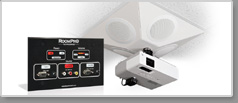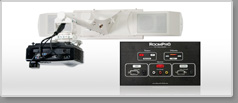Can Your Children Hear Their Teachers?
By Suzanne DeMallie
An eight-year-old boy comes home from school very excited to share information he learned in health class. He turns to his mother and asks, "Mom, did you ever have the mums before?"
"M-U-M-S, are you sure you mean the word M-U-M-S like the plant, or do you mean the word M-U-M-P-S?" she asks him.
"No", he says emphatically, "I mean M-U-M-S. You know, it's this sickness where your neck hurts."
The mother is certain that the correct word is mumps. But he insists that the teacher said "M-U-M-S." The boy is upset and frustrated.
This true story represents the potential ineffectiveness of auditory (sound) learning in our schools that threatens every student's academic potential.
Auditory learning accounts for as much as 75 percent of a child's school day. The teacher uses her or his voice to convey instructions, information, and other messages. The students must effectively receive and comprehend these auditory signals to carry out tasks and learn. As basic as this transaction sounds, children miss up to one-third of what their teacher says.
Auditory learning
The five levels of auditory skill development, from lowest to highest level, are detection, discrimination, recognition, identification, and comprehension. Comprehension is achieved when one can answer a question, follow directions, or hold a conversation. It is important to note is that each level is built upon the prior one, and that the latter four levels are dependent upon the brain's processing of the auditory signals. In other words, you cannot comprehend if you haven't detected and discriminated, or identified, a sound. There are two factors that determine how effectively auditory signals are received and processed: acoustics and one's own hearing abilities.
Acoustics
Poor acoustics can dramatically decrease the effectiveness of teaching. Research has shown that a typical classroom provides an inadequate environment when speaking is the primary tool of instruction. Students in today's classrooms are unable to understand 25-30 percent of what their teacher says because of excessive noise and reverberation, causing many students to "tune out." For some students, this inability to hear lessons properly diminishes their desire to learn or complete tasks.
The most critical acoustical component for determining how effectively a teacher's speaking is heard by students is called the signal-to-noise ratio, or SNR. The SNR basically indicates how much louder the teacher's voice is than background noise. Children require the teacher's voice to be at least 15 decibels louder than the background noise (SNR +15 dB) in order to understand what they are hearing. So, if the teacher is speaking at 60 decibels, the background noise can be no louder than 45 decibels for effective learning. The problem is that although background noise is relatively constant, the teacher's voice declines over distance, reducing the SNR below the required levels.
Most teachers are not aware of how sound travels, and that simply turning their back to the class while they are talking will immediately reduce the loudness of their voice by 10 decibels. Even when the teacher faces the class directly, her or his voice will drop 6 decibels for every doubling of distance. In other words, the teacher's voice will be heard at 60 decibels by a student sitting 3 feet away, at 54 decibels when the student is 6 feet away, at 48 decibels when the student is 12 feet away, and so forth. Research confirms that children seated in the middle and back rows of a classroom are at a hearing disadvantage.
Immature auditory capabilities
Children's hearing capabilities are not fully developed until age 15. Children's brains process auditory signals slower and use more energy to do so than adults' brains. Unlike adults, children cannot automatically fill in the blanks for the missed information when noise muffles a teacher's voice. This is because children do not have a complete "database" of information that has been built over time from experiences and exposure to language. So, in the example given at the beginning of this article, the boy could not have known that the word should have been M-U-M-P-S. How would he know when he has never heard the word before? Therefore, children require a quieter environment and a louder teacher's voice to obtain the same level of auditory comprehension as an adult. While children require an SNR of +15 decibels, adults only require an SNR of +6 decibels (9 decibels lower than children.)
Hearing impairments
Approximately 14.9 percent, or 8 million, school-age children have some degree of temporary or permanent hearing loss in one or both ears. In a Vanderbilt University study, 37 percent of students with a slight hearing loss were found to have failed at least one grade, compared with a 3 percent failure rate for students with normal hearing.
Another group of children experience temporary hearing loss without the knowledge of their parents and teachers. On any given school day, 10-15 percent of elementary school students experience temporary hearing loss from a common ear infection. This mild-to-moderate hearing loss, which can be simulated by plugging your ears with your fingers, is caused by a build-up of fluid. This fluid often builds up well in advance of the infection and remains for 3-6 weeks, even after a full week of antibiotics. Few educators and parents realize just how long this type of hearing loss can last-approximately 6-9 weeks, or 16-25 percent of the school year. Obviously, any type of hearing problem is worsened by poor classroom acoustics.
Additional at-risk populations
Other auditory issues relate to the increasingly diverse student population. In 2000, 11 million of the 58 million children enrolled in grades pre-K through 12, were children of immigrants; 5-11 percent were classified as "minimally English proficient." Research has shown greater speech perception difficulties among English language learners (ELL) in school, particularly in noisy environments. Therefore, the ELL population requires even quieter classrooms and louder teachers' voices to help them close the achievement gap.
The 40 percent of, or approximately 29 million, children coming from low-income families have increased auditory needs as well. One study revealed that children living in poverty receive only 20 percent of the early verbal stimulation at home that their middle-class peers receive. This has two major implications for education. First, the vocabulary of these children is significantly less than that of their peers, so the language "database" they use to "fill in the blanks" (discussed earlier in this article) is less developed. Second, their neurological development is at risk because the auditory centers of the brain are dependent upon stimulation for development.
Sound enhancement technology
Few school facilities are adequately meeting the auditory learning needs of every student. Therefore, educators and concerned parents must devise ways to overcome barriers to auditory learning to ensure that every child has an equal opportunity to succeed. Since it may be impossible to seat each student close enough to the teacher, the most practical solution is to bring the teacher's voice closer to each student's ear through sound enhancement technology.
Sound enhancement technology uses infrared (IR) technology and wireless teacher microphones to amplify the teacher's voice, normally by 8-10 decibels. A receiver then distributes that voice around the classroom through 4-6 strategically placed speakers. The primary benefit is in the even distribution, not the amplification of the teacher's voice. With students sitting no more than 10 feet from one of the ceiling speakers, this allows every student the acoustical advantage of sitting in the front row at a minimal cost. Many systems also come with a handheld microphone for the students to share. The cost of such a system is about $1,500 per classroom.
More than 50 studies have provided evidence supporting the use of classroom sound enhancement. The first study in 1977, funded by the U.S. Department of Education, found that all students, regardless of hearing ability, showed significant gains in academic achievement. Students made gains in reading and language arts at a faster rate, to a higher level, and at one-tenth the cost of students who were moved from regular classes to resource room instruction. This study received national validation status in 1981 and was recertified in 1992.
More recent studies have reported an average increase of 10-15 percent in test scores across all subjects and types of students, with a higher increase among the ELL population (an average of 16 percent). Teachers report that students are more attentive, more on-task, and better behaved. One 2002 study has even pointed to an increase in sound recognition and manipulation among kindergarten students, which is vitally important to learning to read.
Teachers benefit, too, from sound enhancement technology. They report increased mobility, increased physical energy, and reduced absenteeism from vocal fatigue. One study reported a 56 percent decline in elementary teacher absences due to vocal fatigue; keep in mind that teachers talk on average 6.3 hours per day.
Sound enhancement offers other monetary benefits to offset the cost of the systems. Research has shown decreases in the number of special education referrals by as much as 40 percent.
National PTA resolution
In June 2007, the national PTA organization adopted the Classroom Auditory Learning Issues resolution, making education on these auditory issues and advocacy for sound enhancement a national priority. Yet, the majority of parents, teachers, and school administrators still remain uniformed about the problem and its consequences. Every day, children miss information simply because they can't hear the subtle differences that change the meaning of a word. Every day, children are labeled "learning disabled," "ADD," or "lazy" simply because their inability to hear their teachers causes them to lose the desire and ability to learn.
This nation has a long way to go to ensure that all children have acoustically accessible classrooms. Funding this technology provides a good return on our investment in education. Our school boards and politicians need to hear us loud and clear: "Every child deserves to hear their teacher, and every teacher is important enough to be heard!"
For more information, research and advocacy tips, please visit www.classroomhearing.org.
Suzanne DeMallie is founder and executive director of The Institute for Enhanced Classroom Hearing (ECH) in Towson, Maryland, a PTA National Unit member, and a recipient of a 2007 National PTA Life Achievement Award. She wrote the resolution on classroom auditory learning adopted by PTA in 2007.









